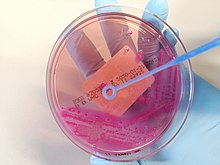Petri dish
[7][8] What was later called Petri dish was originally developed by German physician Robert Koch in his private laboratory in 1881, as a precursor method.Penicillin, the first antibiotic, was discovered in 1929 when Alexander Fleming noticed that penicillium mold contaminating a bacterial culture in a Petri dish had killed the bacteria around it.[10] Koch had published a precursor dish in a booklet in 1881 titled "Zur Untersuchung von Pathogenen Organismen" (Methods for the Study of Pathogenic Organisms),[11] which has been known as the "Bible of Bacteriology".[28] Alternatively, some glass or plastic versions may have small holes around the rim, or ribs on the underside of the cover, to allow for air flow over the culture and prevent water condensation.[29] Some Petri dishes, especially plastic ones, usually feature rings and/or slots on their lids and bases so that they are less prone to sliding off one another when stacked or sticking to a smooth surface by suction.[32][33] Petri dishes can be used to visualize the location of contamination on surfaces, such as kitchen counters and utensils,[34] clothing, food preparation equipment, or animal and human skin.Due to their large open surface, Petri dishes are effective containers to evaporate solvents and dry out precipitates, either at room temperature or in ovens and desiccators.Petri dishes also make convenient temporary storage for samples, especially liquid, granular, or powdered ones, and small objects such as insects or seeds.Their transparency and flat profile allows the contents to be inspected with the naked eye, magnifying glass, or low-power microscope without removing the lid.


growth mediumculturedbacteriamossesbacteriologistJulius Richard Petriculture platepopular cultureRobert KochPenicillinAlexander FlemingbacterialBerlin UniversityInternational Medical CongressLouis PasteurtuberculosisMycobacterium tuberculosisanthraxBacillus anthracisVibrio choleraeNobel Prize in Physiology or MedicineFriedrich LoefflerglandersBurkholderia malleidiphtheriaCorynebacterium diphtheriaeGeorg Theodor August GaffkytyphoidSalmonella entericacylindricalborosilicate glasssterilizationplasticmicroscopemicroplatecell culturePhyscomitrella patensagarplatecultivateyeastsculture mediumagar plateagarosecarbohydratesamino acidsindicatorsmedicinal drugsinoculatedincubatorsporescell cultivationeukaryoticimmunodiffusiongerminationsolventsprecipitatesdesiccatorsmagnifying glassUnicodecode pointHTML entityMicrobial artCell spreaderInoculation loopRoux culture bottleRalf ReskiWayback MachineAmerican Heritage DictionaryBibcodeAlcohol burnerBunsen burnerDesiccatorHeating mantleHot plateLab ovenMeker–Fisher burnerTeclu burnerWater bathVacuum dry boxChemostatHomogenizerLiquid whistleMagnetic stirrerMortar and pestleShakerSonicatorStatic mixerStirring rodVortex mixerWash bottleClampsClamp holderTripodBurette clampIron ringRetort standTest tube holderTest tube rackWire gauzeLab drying rackCryogenic storage dewarLaminar flow cabinetMicrotiter platePicotiter plateRefrigeratorAspiratorAutoclaveCork borerCrucibleFilter paperForcepsCentrifugePipeclay triangleSpectrophotometerSplintStopperScoopulaSpatulaTest tube brushWire brushInoculation needleGlasswareDean–StarkSoxhlet extractorKipp'sBoston round